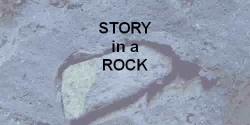The Oldest Thing
The Oldest Thing you will ever see
comes from outer space! - Meteorites!
The metallic meteorite shown above
Billions of years ago the metal was formed in an exploding star, a supernova.
During the explosion the pressures were unbelievably huge ,
so much so that they forced lighter atoms together to form heavier metallic atoms.
Later on the metal ended up in the cores of rocky planets or ended up in the asteroid belt.
So the metallic meteorite you see above is one of the oldest objects you will ever see!
billions of years old, as old as the stars and much much older than the earth!
This specimen fell to earth from outer space and landed in southern Africa
The stony meteorite you see above is the result of the collision of asteroids.
Between the rocky inner planets and the gaseous outer planets is an area where a planet tried to form but couldn't make up its mind whether to be rocky or gaseous. It ended up being neither, just a jumble of pieces instead.
This specimen is from the Wolf Creek area in central Australia.
Asteroids date back to the formation of our solar system and are generally at least 4 billion years old.
Some less common stony meteorites are bits of planets and moons, thrown into space by collisions, impacts or volcanic eruptions.
These unusual meteorites give us an insight into the composition of the moons and other planets.
The tektites shown above are much younger meteorites.
While some debate rages, they are thought to have originated on the earth or our moon.
They are bits of silica rich rock, ejected into space for a short journey, until dragged back to earth by gravity,
either as molten blobs of volcanic origin or as small chunks of crust.
The short space journey quickly liquifies then just as quickly supercools the chunks turning them into pieces of glass.
Their shapes reflect the best shapes for re-entering the atmosphere and mimic the shapes of the re-entry capsules of modern space craft..
The specimens above are from central Australia and northern Vietnam and are just tens of thousands to hundreds of thousands of years old - babies as far a meteorites go!
How can we tell where they come from?
Well we can compare them to rocks collected on the moon and collected or observed by visiting spacecraft.
Only a few meteorites resemble these rocks.
We can observe the orientation of crystals in meteorites to determine if they solidified in a strong gravitational field.
Strong gravity will result in more oriented crystals - meaning they came from a larger body such as a planet.
This has allowed scientists to infer that some very rare types of meteorites come from Mars--apparently blasted off the surface of that planet by a meteorite impact.
We can analyse the light reflected from meteorites--a fancy analysis of color--and compare it to light reflected from meteorite specimens found on Earth.
This has allowed scientists to determine that the most likely source for most meteorites is the Asteroid Belt between Jupiter and Mars.
Learn about meteorites in detail on this website! --- visit ----> METEORITES and METEORITES AND EXTINCTIONS and TEKTITES and IMPACT CRATERS

